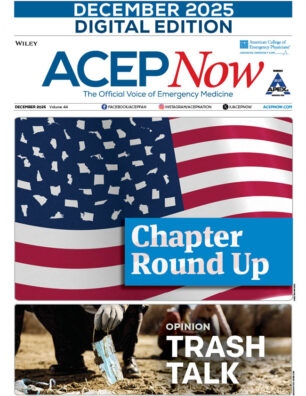Question: What is the incidence of rheumatic fever in children in the United States?
Explore This Issue
ACEP Now: Vol 42 – No 09 – September 2023Acute rheumatic fever (ARF) is a potential consequence of group A streptococcal (GAS) infections and was the leading cause of mortality in children in the early 20th century.1,2 It is an autoimmune antibody response following a GAS infection that leads to cardiac inflammation.2 Chronic rheumatic heart disease is when the cardiac changes from acute rheumatic fever develop into permanent heart-valve damage. We are going to focus on ARF for this discussion. Initial diagnosis of ARF includes a combination of major and minor criteria—typically, two major criteria or one major and two minor criteria. The major criteria are: arthritis, carditis, subcutaneous nodules, erythema marginatum, and Sydenham’s chorea. Minor criteria include: polyarthralgia, fever at least 38.5 degrees C, erythrocyte sedimentation rate at least 60 mm/hr, C-reactive protein at least 3 mg/dL (i.e., at least 30 mg/L), or prolonged PR interval for age.1-3 While the major criteria of carditis used to include a new murmur on auscultation—suggesting a valvular dysfunction—the newer 2015 revised Jones Criteria for diagnosis now include the ability to diagnosis subclinical carditis via echocardiography.3 The major health burden of ARF occurs in low- and middle-income countries, with low incidence in affluent countries (such as the United States). It is important to note, though, that certain populations tend to be disproportionally affected and these include indigenous Samoan, Hawaiian, Native American, and Alaskan native populations.2 So how common is ARF in the United States overall? While there are reports of ARF deaths exceeding 1,000 children and adolescents in New York City in a single year in the late 1930s, there has been a significant decline.4 More recent data can be found in a 2019 retrospective review of data from the Kids Inpatient Database as part of the Healthcare Cost and Utilization Project.5 Pediatric discharges were reported by 2,784 hospitals in 2000 and the number of reporting hospitals increased to 4,179 in 2012. This database systematically and randomly samples pediatric discharges from participating hospitals. From these data, the authors looked at five reporting periods—2000, 2003, 2006, 2009, and 2012—and identified ARF case incidences of 0.63, 0.77, 0.64, 0.51, and 0.52, respectively, per 100,000 children. While the incidence is low, there are still between 408 and 599 cases of ARF in each of these selected years of study in the United States. Depending on your patient population, you should still keep ARF on your differential diagnosis list.
Summary
The incidence of pediatric acute rheumatic fever in the United States appears to range from 0.51 to 0.77 per 100,000 children and physicians should consider the diagnosis in the right clinical setting.
 Dr. Jones is assistant professor of pediatric emergency medicine at the University of Kentucky in Lexington.
Dr. Jones is assistant professor of pediatric emergency medicine at the University of Kentucky in Lexington.
 Dr. Cantor is professor of emergency medicine and pediatrics, director of the pediatric emergency department, and medical director of the Central New York Regional Poison Control Center at Upstate Medical University in Syracuse, New York.
Dr. Cantor is professor of emergency medicine and pediatrics, director of the pediatric emergency department, and medical director of the Central New York Regional Poison Control Center at Upstate Medical University in Syracuse, New York.
References
- Ilgenfritz S, Dowlatshahi C, Salkind A. Acute rheumatic fever: case report and review for emergency physicians. J Emerg Med. 2013;45(4):e103-6.
- de Loizaga SR, Beaton AZ. Rheumatic fever and rheumatic heart disease in the United States. Pediatr Ann. 2021;50(3):e98-e104.
- Gewitz MH, Baltimore RS, Tani LY, et al. Revision of the Jones Criteria for the diagnosis of acute rheumatic fever in the era of Doppler echocardiography: a scientific statement from the American Heart Association. Circulation. 2015;131(20):1806-18.
- Bland EF. Rheumatic fever: the way it was. Circulation. 1987;76(6):1190-5.
- Bradley-Hewitt T, Longenecker CT, Nikomo V, et al. Trends and presentation patterns of acute rheumatic fever hospitalizations in the United States. Cardiol Young. 2019;29(11):1387-1390.
Pages: 1 2 | Multi-Page





No Responses to “Diagnosing Acute Rheumatic Fever in Kids”